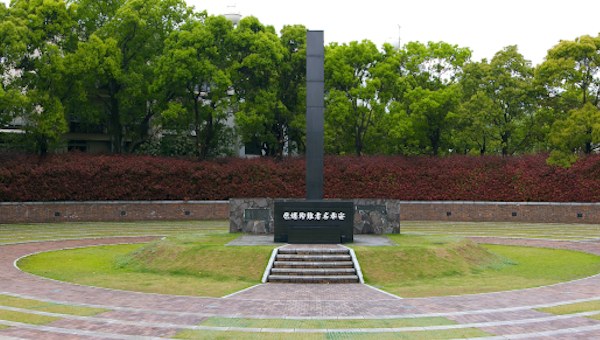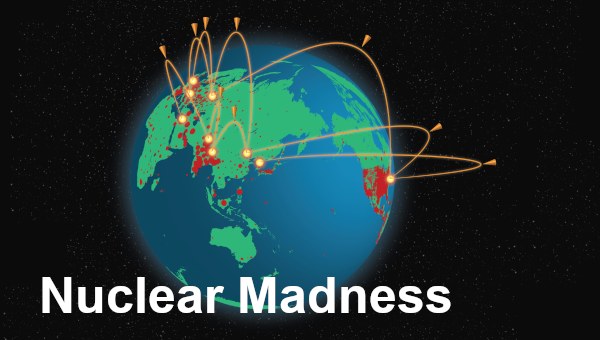At this most critical of times, do current erroneous assumptions about human nature play a role at a deep level in the prevalent responses to catastrophes? Apropos, Raymond Williams summarized Antonio Gramsci’s view of hegemony as a “central system of practices, meanings and values saturating the consciousness of a society at a much deeper level than ordinary notions of ideology.”1
 There are new and old normals and it is hard to know where public knowledge is on this. Movies from similar times evoked normal, even beautiful scenes from daily life, of intimacy and love, but with ordinary life shadowed by foreboding threats: The Garden of the Finzi Continis under Fascism, Burnt by the Sun under Stalin’s terror, Hiroshima Mon Amour and nuclear holocaust. Focusing on Donald Trump and immediate realities is urgent, but now looms the specter of human extinction.
There are new and old normals and it is hard to know where public knowledge is on this. Movies from similar times evoked normal, even beautiful scenes from daily life, of intimacy and love, but with ordinary life shadowed by foreboding threats: The Garden of the Finzi Continis under Fascism, Burnt by the Sun under Stalin’s terror, Hiroshima Mon Amour and nuclear holocaust. Focusing on Donald Trump and immediate realities is urgent, but now looms the specter of human extinction.
Trump has brought increased attention to social pathology. An observation made by Canadian First Nations lawyer Pamela Palmater pinpoints a core problem in Canada when it comes to understanding people and society, but it is applicable to the broad public. She writes that “the difficult part about public discourse related to genocide is that the majority of Canadians don’t have all the facts.” The public knows even less about the extinction threat of nuclear weapons and climate change.
Human Nature?
Cognitive science, biology and American psychiatry now assume the mantle of defining human nature. Behavior is said to be hard-wired, “in the brain,” programmed, in the DNA.2 Humans are presumed to be addicted to consumption, unable to forego gratification, unable to endure stress and frustration, require optimism and success. They are primarily motivated by self-interest, do not have a rational understanding of time as they are unable to think much beyond the immediate future, are capable of relating or empathizing at most to a small group of people, and predisposed to fight/flight/freeze reactions.
Human psychology is understood through algorithms and brain imaging. The field of Game Theory gave us the Prisoner’s Dilemma which is about self-serving behavior. Artificial Intelligence can be programmed to make moral decisions. Emotions are said to come from a primitive part of the brain. This is all far removed from what people actually do. Real prisoners have great capacity to cooperate such as in prisoners’ strikes, and even the most violent criminal acts cannot be reduced to a formula but are highly individual. Rage, too, can be moral: Benjamin Ferencz, the 97-years-old, last-surviving Nuremberg prosecutor, says that he is “boiling with anger all the time” and “won’t give up fighting for peace.”
This human nature model arose at the same time as neoliberalism and management theory. William James wrote about a distinctly American version coming from the widespread practice of instantaneous born-again religious experience – no crise de conscience required. The enshrining of the pursuit of happiness, positive thinking, and optimism glosses over the actual state of the world and over the wide range of human experience. The individualistic ideal of “full self-realization of human potential” is a compelling promise of capitalist and even some anti-capitalist movements and is libertarian and ahistorical.
The words ‘people’, ‘person’, and ‘human’ are themselves corrupted. In today’s world, many people are not considered persons at all. As the late poet Eduardo Galeano writes, more and more of the world’s people are:
“The nobodies: nobody’s children, owners of nothing.
The nobodies: the no-ones, the nobodied, …
Who are not human beings, but human resources.
Who do not have names, but numbers.”
George Monbiot exposed how Britain’s chief economist, Nicholas Stern, quantified people’s right to live on the basis of wealth: Stern justified expanding Heathrow airport capacity because a rich person would lose money having to wait for a flight, and this wealth was worth more than the wealth of people dying due to aviation’s high greenhouse gas emissions (Heathrow is slated to add 260,000 extra flights/year, and aviation emissions remain exempt under Kyoto).
“Personhood” leaves out real people. Corporations, citizens from certain countries, and special categories of refugees qualify for various personhood rights. Populationists and some environmentalists fetishize a pristine nature without people and believe that there are “too many people” for the Earth’s carrying capacity (billions too many according to GAIA guru James Lovelock). Only select persons suffer trauma and “humanitarian disasters.” “Humanitarian” is degraded by the doctrine of the “least possible evil” which allows horrific violence if it is calculated to be less than even worse possible violence.3
Inaction about the critical situation is often attributed to denial. But is it really denial if the facts are not even known. And does knowledge about severe threats necessarily lead to denial? Other psychological processes differ from the prevalent human nature framing.
Anxiety can arise because of the realistic perception of a danger situation. Freud’s view is that anxiety does not necessarily become overwhelming. The signal of anxiety can lead to a pause that delays action and that allows time to assess a threat.
There is a maturational capacity to understand objective reality, what Freud called “secondary process” thinking. This contrasts with “primary process” as seen in dreams and in the thinking of young children: the absence of a realistic sense of the duration of time, egocentric theories of causality, conflating words with things, reversal of meanings, confusions about animate and inanimate. These early forms of thinking can persist for many reasons.
Mature adults are capable of having a constant sense of other people’s existence so that no one is invisible. This is closely tied to being able to feel ambivalence, that the world is not simply divided between ideal good people and evil bad people. Early on, young children comfort themselves with ideal good objects like soft furry animals. The soft, furry polar bear on melting ice has come to signify the tragedy of climate change; what about concern for the tragedy of all other people in the world?
The world’s people are generally left out of discourses on climate change and nuclear weapons. Manhattan Project Nobel Prize winner Richard Feynman reported that after the first atom bomb test at Alamogordo, “’There were tears and laughter…. We beat each other on the back, our elation knew no bounds …. the gadget worked!’ Feynman got his bongo drums out and led a snake dance through the whole Tech Area.”4 In a 1975 talk about Los Alamos, Feynman recalled how he looked at the world differently, picturing destroyed bridges and buildings – but how about the people? It is only since the 2014 Vienna Humanitarian Pledge that there is focus on the human consequences of nuclear war.
As in the animistic thinking of young children, climate change is discussed as a de-personalized threat to the ‘planet’, to ‘civilization as we know it’, to ‘organized civilization’, but not as a current killer of hundreds of thousands of people. Climate itself is personified, as in fighting, defeating, battling, combating climate rather than the people and practices causing it. Reports of species extinctions leave out the catastrophe for people. The geological term “Anthropocene” puts into the perspective of eons the rapidity and extent of anthropogenic climate change, but it also abstracts and distracts from the specific people who are so wholly culpable and from the time scale of a miniscule few years for the needed radical changes.
There are wild gaps in reality testing. Jim White, a climate scientist begins a lecture by dropping a pencil on the ground. He demonstrates the physical law of gravity which he cannot change, but he can change his own behavior and choose not to drop the pencil. Barack Obama spoke at Hiroshima as if atom bombs just dropped out of the sky. Current agreements and solutions to climate and nuclear threats ignore the physical laws of nature, as if physical laws can wait, and as if humans are incapable of stopping. Since the 1960s when both extinction threats were known, the response has been to “transition.”
Time frames are cited arbitrarily and without context. Launch time for nuclear weapons on high-alert is inconsistently reported as several minutes, 9 minutes, 15 minutes. The human context is that Russians do not have a missile defense system that can detect missiles over the horizon, so their decision to launch a strike would have to be made within minutes, without accurately knowing whether there are indeed incoming nuclear missiles. President Trump is impulsive so there is no time for thinking and for reality testing.
Global Climate Change
The number signifying global temperature is reified as a thing in itself. In a recent interview, Naomi Klein told Jeremy Scahill “we still have a chance of halting warming at 2C, or even the Paris target of 1.5C. But if we do everything we can and mobilize wartime efforts, we could move quickly enough to prevent warming of more than two degrees, or if we are extremely lucky, 1.5 degrees Celsius.” This is incorrect. The baseline for measuring the 1.2C rise in temperature due to climate change is inconsistently reported as 1780, 1880, 1945 – the dating makes a huge difference in understanding the accelerated rate of change because there has been a 0.2C in just the last few years. Overshooting the 1.5C target is inevitable within a few years. 1.5C is twice the global average temperature increase that has already caused major shifts in the entire Earth climate system.
In the climate system, heat absorption in the ocean, and the changing proportion of fresh to salt water due to melting ice, already cause changes in ocean stratification leading to decreased oxygen, to shifting ocean currents (changing Gulf Stream), interactions with the atmosphere (changing jet stream), accelerated melting of ice shelves from below due to contact with the warming ocean, powerful waves eroding the grounding line so that melting glaciers can flow into the sea. The effect of fresh water infusion becomes self-generating and amplifying. Climate modelling has substantially underestimated the amount of sea level rise and of oxygen depletion.
There are many human causes of these disasters, but not hard-wiring. The safety of humanity becomes secondary to group loyalty, subservience to authority, association with narcissistic leaders. Climate scientists write about these processes within scientific groups that interfere with objectivity.5 Robert J. Lifton describes intense male bonding among groups of nuclear weapons scientists who “didn’t want to appear weak.” Male narcissism is endemic in the national security insider group and puerile male bonding in elite financial cliques like the Bohemian Club and Yale’s Skull and Bones.6
Climate scientists at times put forth erroneous assumptions about human nature. James Hansen’s fee-and-dividend carbon tax assumes that only higher carbon prices combined with monetary rewards will change behavior. Climatologist Michael Mann assumes that drought was a main cause of Syrian violence, overlooking severe immiseration due to neoliberal restructuring and land enclosures that caused huge migration into urban slums. Historically, droughts and water conflict in themselves do not cause violence; people have customarily worked out agreements to share resources. The misinterpretation of violence is accepted as fact and has already become the rationale for the militarization of climate security. Guy McPherson advises people to enjoy today – carpe diem, as if people cannot sustain a range of difficult feelings, hard work, interdependence, and a realistic sense of what needs to be done right now and in the long term.
After years of proliferating nuclear weapons and greenhouse gas emissions, the main solutions remain war and ‘green’ technology. It is simply assumed that people can’t talk together and plan the logical cutbacks that would immediately reduce greenhouse gas emissions and water loss and save lives. The big energy and water users are aviation and shipping, the military, mining, inessential manufacturing, industrial agriculture, cement and steel production, the internet. Saving lives requires open borders and debt abolition – not just renewable energy. There is a magical wish that progressive institutions will someday fix everything without taking into account the critical time frame posed by the Earth’s physical laws. The bogeyman is economic collapse, even though that economy is destroying the world’s majority population. Current efforts to address these crises are partial and in disarray. In Greek tragedy, the chorus bemoans too late what could have been known and simply waits for the deus ex machina. Our survival depends on mature concern and responsibility for all people. •





